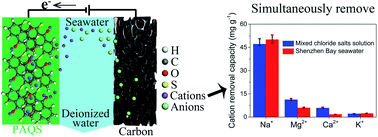A highly efficient porous conductive polymer electrode for seawater desalination†
Abstract
Porous and conductive organic polymer materials are of great importance to achieve high-efficiency desalination by using the battery deionization technique. Herein, the first conductive porous polymer electrode, based on poly(anthraquinonyl sulfide) (PAQS), has been successfully fabricated and demonstrated with high efficiency for natural seawater battery deionization (BDI). The merits of this electrode benefit from the low charge transfer resistance, abundant pores and highly redox-active characteristics of PAQS. Moreover, different from reported materials, the as-fabricated electrode can be used to remove multiple cations simultaneously from natural seawater. The removal capacity achieved in natural seawater for Na+, K+, Mg2+, and Ca2+ is up to 50.0 mg g−1, 2.3 mg g−1, 5.9 mg g−1, and 1.7 mg g−1, respectively. A detailed mechanism study reveals that PAQS undergoes a multiple ion insertion and extraction process through a reversible redox reaction within the C![[double bond, length as m-dash]](https://www.rsc.org/images/entities/char_e001.gif) O groups of PAQS during the electrochemical process. The present study not only reported the first porous conductive polymer electrode for highly efficient BDI, but also paves the way for developing novel organic polymer electrodes for seawater and saline water desalination.
O groups of PAQS during the electrochemical process. The present study not only reported the first porous conductive polymer electrode for highly efficient BDI, but also paves the way for developing novel organic polymer electrodes for seawater and saline water desalination.



 Please wait while we load your content...
Please wait while we load your content...